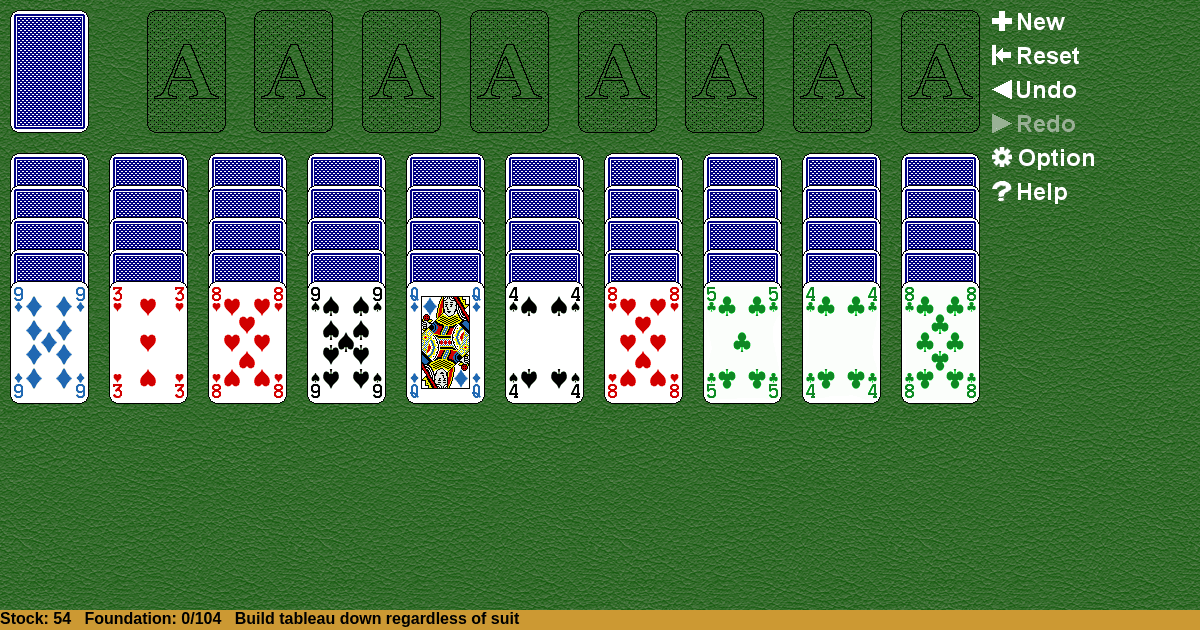Grounds for Divorce
Home |
How to play |
FAQ |
About
How to play Grounds for Divorce?
Game Objective:
The primary goal in Grounds for Divorce Solitaire is to discard all cards by creating complete sequences from King down to Ace of the same suit within the tableau. When a full suit sequence is assembled, it is automatically removed from play. The game is won when no cards remain on the tableau or in the stock.
Setup & Layout:
- Deck: Two standard 52-card decks are used, totaling 104 cards.
- Tableau: There are ten tableau piles.
- Each tableau pile is initially dealt five cards: the bottom four cards are face-down, and the top card is face-up.
- Stock: The remaining cards form the stock pile, which is used to replenish the tableau during play.
- Play Areas Defined:
- Tableau: The main area where cards are built down and sequences are formed.
- Stock: The pile from which cards are dealt onto the tableau.
- Face Orientation:
- In each tableau, four cards are face-down and one card (topmost) is face-up.
Grounds for Divorce Solitaire Rules:
- Building on Tableau:
- Cards are built downward regardless of suit (e.g., any Jack may be placed on any Queen).
- However, complete sequences must be in the same suit (King through Ace) to be removed from play.
- Sequences built down in the same suit can be moved together as a group.
- Only one card or a valid sequence may be moved to another tableau pile at a time.
- Kings cannot be placed on Aces; building is strictly downward, ending at Ace.
- Moving Cards:
- Any single card or a valid sequence (built down in suit) can be moved to fill an empty tableau pile.
- There is no restriction by suit or color for general building, but only same-suit sequences can be removed.
- Stock Dealing:
- When no tableau pile is empty, a single card is dealt face-up from the stock to each tableau pile.
- Only one pass through the stock is permitted; redeals are not allowed.
- Cards dealt from the stock remain on the tableau until used in a valid move.
Gameplay:
- Typical Sequence of Actions:
- Move cards or sequences between tableau piles to build down.
- Assemble sequences of King through Ace in the same suit; these are automatically discarded when complete.
- Fill empty tableau piles with any card or valid sequence.
- When all tableau piles have at least one card, deal one card from the stock to each tableau pile.
- Introducing New Cards:
- Cards are introduced from the stock only when no tableau pile is empty.
- No cards are dealt to empty tableau spaces from the stock.
- No More Legal Moves:
- If no moves are possible and the stock is exhausted, the game ends. If cards remain, the game is lost.
Winning & Losing Conditions:
- Winning Condition:
- The game is won when all cards have been discarded by forming complete King-to-Ace sequences in suit, leaving no cards in the tableau or stock.
- Losing Condition:
- The game is lost if no more legal moves can be made and cards remain in the tableau or stock after the stock is exhausted.
Special Rules & Edge Cases:
- Filling Empty Tableaus:
- Any card or valid sequence (built down by suit) may be moved to fill an empty tableau pile.
- Stock Restrictions:
- Cards are only dealt from the stock when all tableau piles have at least one card; empty piles prevent stock dealing.
- Only a single pass through the stock is allowed; no redeals.
- Sequence Removal:
- Only full sequences from King to Ace in the same suit are removed; partial sequences or mixed suits remain.
- Group Moves:
- Sequences built down in the same suit may be moved together as a group; mixed-suit sequences cannot be moved as a unit.
- No Foundations:
- Unlike many solitaire games, there are no foundation piles; all play occurs within the tableau and stock.
Definitions:
- Tableau: The primary area where cards are arranged and manipulated during play.
- Stock: The pile of undealt cards used to replenish the tableau.
- Sequence: A run of cards in descending order, ideally all in the same suit for removal.
This guide provides a complete and precise reference for playing Grounds for Divorce Solitaire according to official rules and authoritative sources.

Solitaire Collection
About Grounds for Divorce
Rate (Grounds for Divorce)
4.7 / 5
1,916 votes



























































